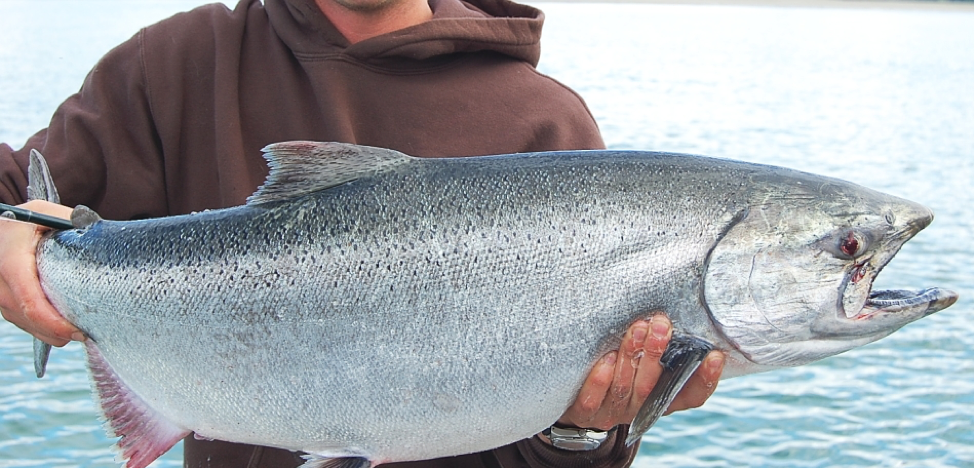Photo by Arne Johnson
By: Mark Hieronymus
The mighty Chinook salmon, the largest of the Pacific salmon species and the state fish of Alaska, is shrinking, according to a recent article in Fish and Fisheries (2018). Fisheries researchers from Alaska and Washington analyzed several databases spanning more than 40 years and looked at over 1.5 million individual measurements for 85 Chinook salmon populations with ocean-entry locations along the west coast of North America from California to Alaska, and the results show a distinct downward trend in both body size and age at maturity for Chinook coastwide.
The study found that average Chinook lengths in some populations have gone down by nearly 10% from the late 1970’s, with most of that drop occurring in the last 15 to 20 years. The researchers also noted a downward trend in age at maturity – Chinook that spend 4 and 5 years at sea are getting harder to come by, and the bulk of the females are returning to spawn after only 3 years at sea, most markedly in the population that spawns in Southeast Alaska.
Most Chinook salmon spend 1 or 2 years in freshwater before going to sea, where they feed voraciously for 2 to 5 years before returning to their natal rivers to spawn and die. The reduction in length and age at maturity has consequences for spawning populations – The females that have been at sea for 4 or 5 years have more eggs than smaller, younger females, and the larger females have more success than smaller-bodied females in digging a redd (spawning bed) in the large cobble preferred by spawning Chinook.
As one may imagine, this is not good news for Southeast Alaska’s already-imperiled Chinook stocks. 3 of the 34 total discrete Chinook populations that spawn in Southeast Alaska have been labeled “Stocks of Concern” after not having enough adults returning to spawn several years in succession. In addition, several other regional watersheds – including the Taku and the Stikine, which produce about 80% of the regions wild Chinook – have had record-low returns, and the near-term outlook is for more low record-low returns. The decline of the 4 and 5 ocean-aged females translates to fewer smolt (juvenile salmon leaving freshwater) per spawner, with the implication that things may not be getting better for the Chinook of Southeast Alaska for quite some time.
The researchers have some theories about what may be driving these changes. One of these drivers might be selective fishery pressure as anglers and commercial fishers alike are targeting the largest salmon, thereby removing them from the gene pool. Another driver may be rapidly changing environmental conditions which are in turn changing the ocean in which these fish pasture for several years. As the ocean environment changes, the food base the Chinook rely on may be changing as well, at a rate they may be unable to quickly adapt to. Researchers also looked at the potential effects of hatchery-produced salmon on the size and age at maturity of Chinook, but the linkage was inconclusive at best as hatchery Chinook are displaying the same decline in size and age at maturity.
In addition to the hypotheses of selective fishery pressure and oceanic / environmental conditions, the researchers also suspect that predation by marine mammals may be taking a toll. They note that Orca (also called killer whale) populations have doubled and possibly tripled during the range of the study. Orcas are known to have a sweet tooth for the large, fatty king salmon, and previous research suggests annual Orca predation on Chinook from California to Alaska could total more than 2 million adult Chinook.
While it may be easy to point the finger at overfishing, ocean conditions, hatcheries, and whales, the researchers conclude their findings with a cautionary note – “Our qualitative assessment of the potential causes of changes in age-size structure suggests that common hypotheses such as harvest, environmental change and hatchery effects are not consistent with nor sufficient to explain observed patterns of demographic change in Chinook salmon observed across space and time. The causes of the declining size and age trends are likely complex and involve multiple factors that may interact. Changes in predation rates on the oldest and largest fish by expanding populations of resident killer whales is a hypothesis that appears largely consistent with the observed changes, but it remains untested. In the light of the presented findings, this and other hypotheses should be evaluated in more detail in future studies before firm conclusions about the underlying causes can be drawn.”
Let’s hope our Chinook stick around long enough for us to find out.
Read the full article HERE
Mark Hieronymus is the Sportfish Outreach Coordinator for Southeast Alaska by winter, and a flyfishing guide for Bear Creek Outfitters in the summer. Mark is based in Juneau, Alaska.


